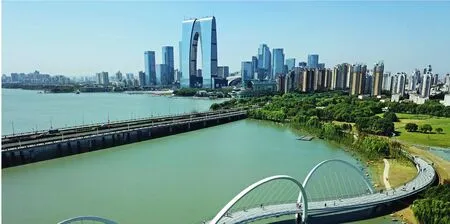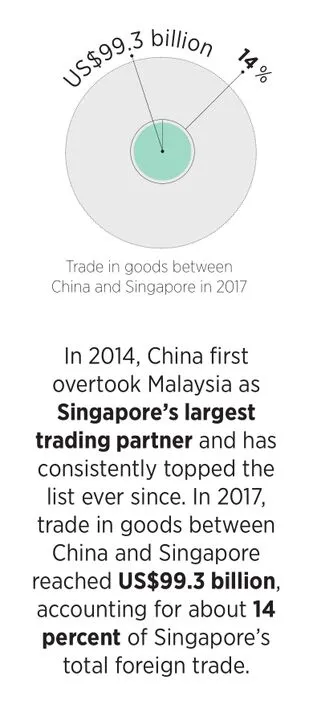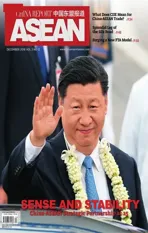FORGING A NEW FTA MODEL
2018-12-25ByLiWeiLuoYifu
By Li Wei, Luo Yifu

The newly-built greenway across Jinji Lake in China-Singapore Suzhou Industrial Park.
On November 12, Chinese Premier Li Keqiang and Singaporean Prime Minister Lee Hsien Loong witnessed representatives of their respective governments signProtocol to Upgrade the Free Trade Agreement in Singapore. The signing of the protocol heralds deepening of economic and trade relations between the two countries—the most important and substantial achievement China has made in the construction of free trade areas. This is also the third upgraded bilateral free trade agreement(FTA) China has signed with foreign partners after agreements with ASEAN and Chile.
As a high-level FTA, the upgraded China-Singapore FTA is an important move for China to learn from and absorb new global economic and trade rules. It could provide a model for China’s construction of a highlevel global free trade network as China demonstrates its willingness and determination to actively participate in new globalization.
Cooperation Upgrade
In 2006, the Chinese and Singaporean governments started negotiations on an FTA that was formally signed two years later. The process of upgrading the deal has been relatively smooth. Since November 2015, eight rounds of negotiations were carried out over three years before the protocol was successfully completed.
The upgrade is bringing China and Singapore new breakthroughs in opening trade and cooperation in foreign financial investment, including the following:
China has for the first time made binding commitments “to establish a customs single window”in an FTA, with a commitment to a foreign partner to make binding pre-adjudication decisions on valuation methods and criteria for commodity prices.For the third time, China has obtained Singapore’s“Qualifying Full Bank (QFB)” and become the country with the largest number of QFB licenses in Singapore.Singapore, for its part, has achieved the highest level of openness in the field of express delivery services,with no restrictions on market access or national treatment. As a result, the consensus and rules in the protocol represent the highest level of bilateral FTAs signed by China to some extent.
Compared to other bilateral FTAs, the process of negotiating the FTA between China and Singapore was particularly smooth and advanced due to the close economic ties and geographical proximity between the two countries.
The close economic ties between China and Singapore are reflected in bilateral trade and investment numbers. Since China overtook the United States as Singapore’s second largest goods trading partner (after Malaysia) in 2007, bilateral trade has made new breakthroughs: In 2014, China first overtook Malaysia as Singapore’s largest trading partner and has consistently topped the list ever since. In 2017, trade in goods between China and Singapore reached US$99.3 billion, accounting for about 14 percent of Singapore’s total foreign trade. In terms of foreign direct investment (FDI), Singapore has been China’s largest source of FDI for the fifth year in a row. Furthermore, the crossborder economic cooperation zone jointly established by China and Singapore has become an important link strengthening economic ties between the two countries,laying the foundation for expanding trade exchange and strengthening investment cooperation between them, which in turn generates higher demand for greater economic openness between the two sides. This dynamic has been one of the main drivers for the two governments to move forward with the FTA and upgrade negotiations in an efficient manner.
Furthermore, because of its ideal location at the center of Southeast Asia,Singapore is an important port for China’s western provinces to access the global market through the Indochina Peninsula. It is also one of the main “transfer stations” for China to carry out international entrepot trade. For Singapore, the core power of its economic development is exporting, so expanding the volume of trade between Singapore and China is the main conduit for Singapore to gain economic benefits from China. Based on geographical considerations, there was an urgent need for China and Singapore to upgrade the bilateral FTA. This has been another driver for the swift and efficient upgrading of the bilateral FTA.
Model for Free Trade
The upgraded China-Singapore FTA can now serve as a model for China’s construction of a high-level global free trade network.

First, the China-Singapore FTA and its upgraded version can serve as a model for future FTA negotiations between China and other countries.China has been sustaining a trade deficit with Singapore since 2009. In a constructive manner, the two countries made concessions to each other, as shown in the FTA: Singapore, as a developed country,becomes the first to impose zero tariffs on all goods imported from China; China provides a convenient environment for Singapore’s capital export, learns and absorbs Singapore’s concept of development, and takes the initiative to align itself with the standards of developed countries such as Singapore in terms of trade and investment rules.
Second, with the China-Singapore FTA and its upgraded version as the link, China has further strengthened its economic ties with ASEAN.Previously, China had already reached and upgraded an FTA with ASEAN, but the China-Singapore FTA is China’s only bilateral FTA with an ASEAN member state.Singapore is not only a founding member of ASEAN, but also the country with the highest level of economic development and openness among all Southeast Asian countries. Since the tariff barriers among ASEAN member states are low, the China-Singapore FTA has enabled China to reach the entire ASEAN market through Singapore. Construction of the free trade area between the two countries and its economic benefits can demonstrate the power of these policies to other ASEAN member states.
Third, with ASEAN as a pivot, China has further improved its overall trade openness and foreign investment cooperation. As of November 2018, ASEAN as a whole had reached FTAs with five other economies. Its negotiations with Hong Kong are still under way.Singapore ranks among the global leaders in the number of FTAs. It has signed 20 such agreements with the most important economies in the world including the United States, China, Japan and the European Union. As a representative of developing countries, Vietnam has also been keen on the FTA strategy, with 12 such agreements reached so far.
Having signed the upgraded version of the China-Singapore FTA, China should focus its construction of a global free trade network not only on raising the level of the existing FTA, but also on gradually popularizing the high standards of the agreement and continuously enhancing their integration into the world economy.
